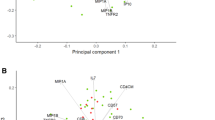Abstract
Cellular entry of human immunodeficiency virus type 1 (HIV-1) requires binding to both CD4 (ref. 1, 2) and to one of the chemokine receptors recently discovered to act as coreceptors3–11. Viruses that infect T-cell lines to form syncytia (syncytium-inducing, SI) are frequently found in late-stage HIV disease and utilize the chemokine receptor CXCR-4; macrophage-tropic viruses are non-syncytium-inducing (NSI), found throughout disease and utilize CCR-5 (ref. 3–11). We postulated that CCR-5 gene defects might reduce infection risk in seronegative subjects and prolong AIDS-free survival in seropositive subjects with NSI but not SI virus. Homozygous (Δccr5/Δccr5) and heterozygous (CCR5/Δccr5) CCR-5 deletions (ccr5)12,13 were found in 7 (2.7%) and 51 (19.5%), respectively, of 261 seronegative subjects from the San Francisco Men's Health Study. CCR-5/Δccr5 genotype was identified in 33 of 172 (19.2%) nonprogressors and 25 of 234 (10.7%) progressors from the seropositive arm of this cohort. The Δccr5 allele conferred a significant protective effect against HIV-1 infection (P = 0.001) and a survival advantage against disease progression (P = 0.02). Although both progressing and nonprogressing CCR5/Δccr5 subjects were identified, a distinct survival advantage was shown for those with NSI virus (P < 0.0001). Thus, the protective effect of Δccr5 against disease progression is lost when the infecting virus uses CXCR-4 as a coreceptor.
This is a preview of subscription content, access via your institution
Access options
Subscribe to this journal
Receive 12 print issues and online access
$209.00 per year
only $17.42 per issue
Buy this article
- Purchase on Springer Link
- Instant access to full article PDF
Prices may be subject to local taxes which are calculated during checkout
Similar content being viewed by others
References
Clapham, P.R., Blanc, D. & Weiss, R.A. Specific cell surface requirements for the infection of CD4-positive cells by human immunodeficiency virus types 1 and 2 and by Simian immunodeficiency virus. Virology 181, 703–715 (1991).
Maddon, P.J. et al. The T4 gene encodes the AIDS virus receptor and is expressed in the immune system and the brain. Cell 47, 333–348 (1986).
Alkhatib, G. et al. CC CKR5: A RANTES, MIP-1α, MIP-1β receptor as a fusion cofactor for macrophage-tropic HIV-1. Science 272, 1955–1958 (1996).
Berson, J.F. et al. A seven-transmembrane domain receptor involved in fusion and entry of T-cell-tropic human immunodeficiency virus type 1 strains. J. Virol. 70, 6288–6295 (1996).
Bleul, C.C. et al. The lymphocyte chemoattractant SDF-1 is a ligand for LESTER/fusin and blocks HIV-1 entry. Nature 382, 829–832 (1996).
Choe, H. et al. The β-chemokine receptors CCR3 and CCR5 facilitate infection by primary HIV-1 isolates. Cell 85, 1135–1148 (1996).
Deng, H. et al. Identification of a major coreceptor for primary isolates of HIV-1. Nature 381, 661–666 (1996).
Doranz, B.J. et al. A dual-tropic primary HIV-1 isolate that uses fusin and the p-chemokine receptors CKR-5, CKR-3, and CKR-2b as fusion cofactors. Cell 85, 1149–1158 (1996).
Dragic, T. et al. HIV-1 entry in to CD4+ cells is mediated by the chemokine receptor CC-CKR-5. Nature 381, 667–673 (1996).
Feng, Y., Broder, C., Kennedy, P.E. & Berger, E.A. HIV-1 entry cofactor: Functional cDNA cloning of a seven-transmembrane G protein-coupled receptor. Science 272, 872–877 (1996).
Oberlin, E. et al. The CXC chemokine SDF-1 is the ligand fo LESTER/fusin and prevents infection by T-cell-line-adapted HIV-1. Nature 382, 833–835 (1996).
Liu, R. et al. Homozygous defect in HIV-1 coreceptor accounts for resistance of some multiply-exposed individuals to HIV-1 infection. Cell 86, 367–377 (1996).
Sampson, M. et al. Resistance to HIV-1 infection in Caucasian individuals bearing mutant alleles of the CCR-5 chemokine receptor gene. Nature 382, 722–725 (1996).
Dean, M. et al. Genetic restriction of HIV-1 infection and progression to AIDS by a deletion allele of the CKR5 structural gene. Science 273, 1856–1862 (1996).
Cao, Y. et al. Virologic and immunologic characterization of long-term survivors of human immunodeficiency virus type 1 infection. New Engl. J. Med. 332, 201–208 (1995).
Sheppard, H.W. et al. The characterization of non-progressors: Long-term HIV-1 infection with stable CD4+ T-cell levels. AIDS 7, 1159–1166 (1993).
Jurriaans, S. et al. The natural history of HIV-1 infection: Virus load and virus phenotype independent determinants of clinical course? Virology 204, 223–233 (1994).
Huang, Y. et al. The role of a mutant CCR5 allele in HIV-1 transmission and disease progression. Nature Med. 2, 1240–1243 (1996).
Zhang, L. et al. HIV-1 subtype and second-receptor use. Nature 383, 768 (1996).
Winkelstein, W., et al. Sexual practices and risk of infection by the human immunodeficiency virus. The San Francisco Men's Health Study. JAMA 257, 321–325 (1987).
Centers for Disease Control and Prevention. 1993 revised classification system for HIV infection and expanded surveillance case definition for AIDS among adolescents and adults. Morb. Mortal Wkly Rep. 41, 1–19 (1992).
Delwart, E.L. et al. Genetic relationships determined by a DNA heteroduplex mobility assay: Analysis of HIV-1 env genes. Science 262, 1257–1261 (1993).
Author information
Authors and Affiliations
Rights and permissions
About this article
Cite this article
Michael, N., Chang, G., Loum, L. et al. The role of viral phenotype and CCR-5 gene defects in HIV-1 transmission and disease progression. Nat Med 3, 338–340 (1997). https://doi.org/10.1038/nm0397-338
Received:
Accepted:
Issue Date:
DOI: https://doi.org/10.1038/nm0397-338
This article is cited by
-
Genomic Exploration of the Brain in People Infected with HIV—Recent Progress and the Road Ahead
Current HIV/AIDS Reports (2023)
-
HIV-1 and human genetic variation
Nature Reviews Genetics (2021)
-
Prevalence of CCR5delta32 in Northeastern Iran
BMC Medical Genetics (2019)
-
Genetic Polymorphisms in the Open Reading Frame of the CCR5 gene From HIV-1 Seronegative and Seropositive Individuals From National Capital Regions of India
Scientific Reports (2019)
-
Pharmacogenomic implications of the evolutionary history of infectious diseases in Africa
The Pharmacogenomics Journal (2017)


